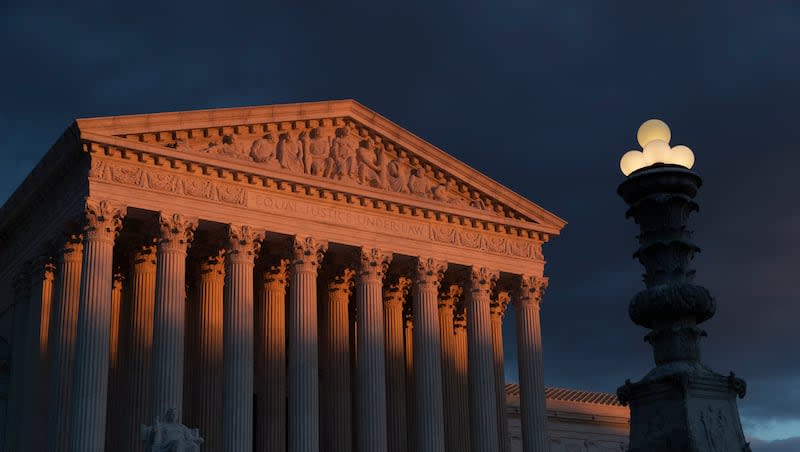Supreme Court rules in favor of South Carolina Republicans in congressional district map dispute

- Oops!Something went wrong.Please try again later.
The Supreme Court has ruled that a Republican-drawn congressional district map was not unconstitutional. A lower court said the map was unconstitutional, declaring it racial gerrymandering. The decision issued Thursday reverses the lower court’s ruling.
The court ruled 6-3. Justice Samuel Alito penned the decision for the majority and Justice Elena Kagan wrote the dissent.
After the Republican-majority state legislature drew new congressional district lines following the 2020 U.S. Census, the South Carolina chapter of the NAACP challenged the map. A Black South Carolina voter named Taiwan Scott, along with the state NAACP chapter, said the state used racial data and moved thousands of Black voters out of the district.
The redistricting had moved almost two-thirds of Black voters in Charleston County from 1st District to 6th District, wrote Amy Howe for SCOTUSblog.
In January 2023, a federal court had ordered the state to draw new congressional district maps by the end of March. The ruling stated GOP leaders had moved Black voters from the 1st District into the 6th District. The judges said in drawing the map, race was used unconstitutionally in the redistricting.
The three-judge panel relied on a case known as Cooper v. Harris. It dealt with the way North Carolina did redistricting. There the court determined the redistricting plan was unconstitutional because race motivated the plan and so it violated the Equal Protection Clause.
About the court’s ruling that South Carolina’s map was drawn unlawfully on discriminatory grounds, Alito said that court “did not offer any direct evidence to support that conclusion, and indeed the direct evidence that is in the record.”
Alito said the staffer who drew the maps “relied on political data from the 2020 presidential election along with traditional districting criteria and input from various lawmakers.”
“The circumstantial evidence falls far short of showing that race, not partisan preferences, drove the districting process, and none of the expert reports offered by the challengers provides any significant support for their position,” said Alito.
In writing the dissent, Kagan said, “The majority is intent on changing the usual rules when it comes to addressing racial-gerrymandering claims.
“The proper response to this case is not to throw up novel roadblocks enabling South Carolina to continue dividing citizens along racial lines,” said Kagan. “It is to respect the plausible — no, the more than plausible — findings of the District Court that the state engaged in race-based districting.
“In the electoral sphere especially, where ‘ugly patterns of pervasive racial discrimination’ have so long governed, we should demand better — of ourselves, of our political representatives and most of all this court,” said Kagan.
Justice Clarence Thomas filed an opinion concurring in part with the majority opinion and said the courts shouldn’t hear these cases.
“In my view, the court has no power to decide these types of claims,” wrote Thomas. “Drawing political districts is a task for politicians, not federal judges. There are no judicially manageable standards for resolving claims about districting, and, regardless, the Constitution commits those issues exclusively to the political branches.”
Previously, the court had ruled that courts can’t weigh in on partisan gerrymandering — the opinion was split on ideological lines. Both Alito and Thomas referenced this case in their rulings.
“Partisan gerrymandering claims present political questions beyond the reach of the federals,” said Chief Justice John Roberts in the 5-4 majority opinion issued in 2019. “Federal judges have no license to reallocate political power between the two major political parties, with no plausible grant of authority in the Constitution, and no legal standards to limit and direct their decisions.”
Kagan also cited it and wrote, “The plain fact is, politicians don’t like admitting to partisan gerrymanders: They often deny them as aggressively as they draw them. That is because ‘excessive partisanship in districting’ is — and is thought by voters to be — ‘incompatible with democratic principles.’”
“We are deeply disappointed in the Supreme Court’s decision to allow South Carolina’s proposed congressional map to stand for yet another election after a unanimous federal three-judge panel recognized the racial discrimination in that map and ordered that a remedial map be used in upcoming elections beginning this year,” said Scott, a plaintiff in the case.
Janette McCarthy-Wallace, NAACP chief general counsel, issued a statement after the ruling calling it “a severe blow to the ideals of democracy.”
“While the court may have faltered in its duty to safeguard democracy, the collective power of the Black vote stands resolute — an unwavering force that transcends legal rulings and political maneuvering,” said McCarthy-Wallace. “The NAACP, in the face of this legal setback, stands in unwavering solidarity with its counterparts fighting legal battles for the protection and expansion of Black voting rights.”

